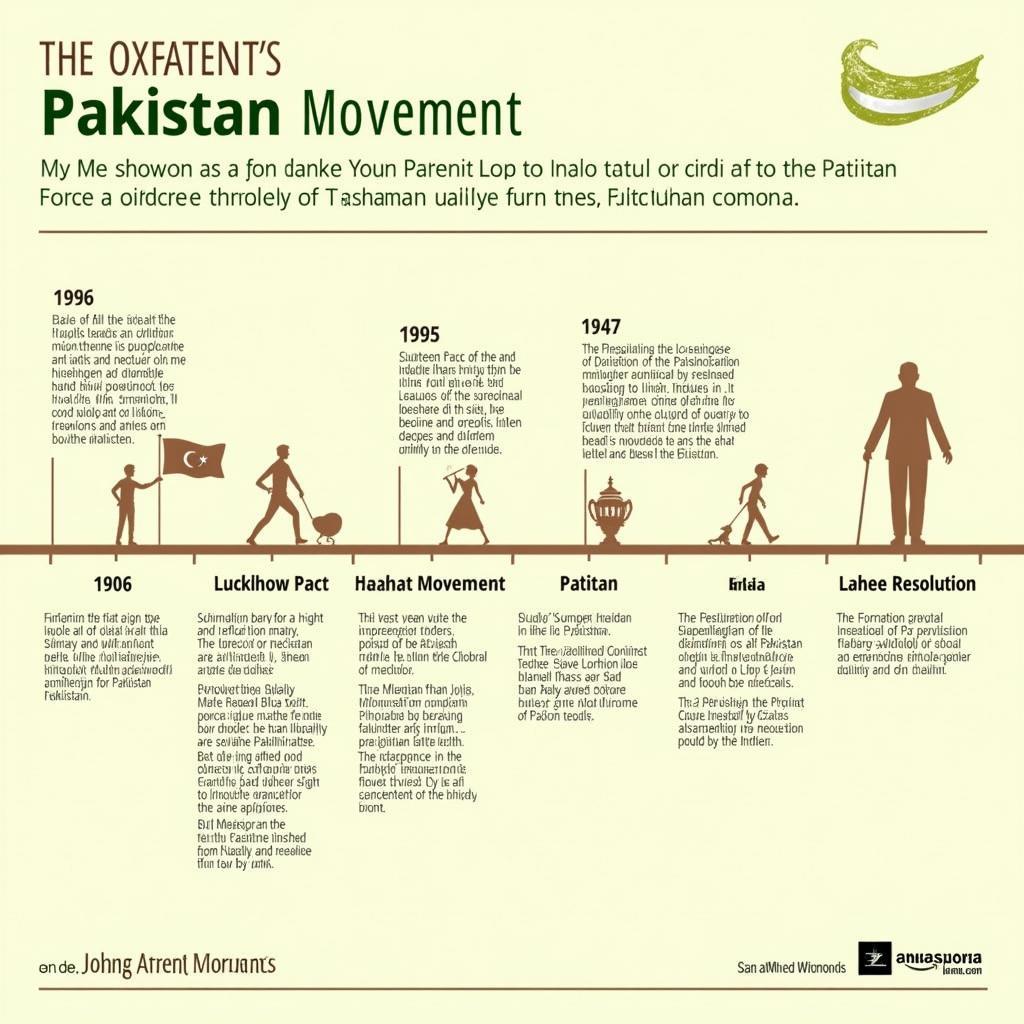The Pakistan Movement, spanning from 1906 to 1947, is a crucial period in South Asian history. A deep dive into the “Pakistan Movement 1906 To 1947 Pdf” reveals the complex socio-political factors that led to the creation of Pakistan. This article will explore the key events, personalities, and ideologies that shaped this transformative era.
The All-India Muslim League, founded in 1906, initially focused on safeguarding Muslim interests within British India. However, growing concerns about Hindu dominance and the desire for self-determination gradually steered the movement towards the demand for a separate Muslim state. The Lahore Resolution of 1940, a pivotal moment, formally articulated this demand, marking a significant turning point in the Pakistan Movement.
Key Figures and Ideologies of the Pakistan Movement
The Pakistan Movement was propelled by influential leaders who mobilized Muslim masses and articulated their aspirations. Muhammad Ali Jinnah, the Quaid-e-Azam, emerged as the central figure, his unwavering leadership and advocacy for a separate nation proving instrumental in achieving the movement’s goal. Other prominent figures like Liaquat Ali Khan and Fatima Jinnah played crucial roles in shaping the movement’s direction and mobilizing support.
The ideology underpinning the Pakistan Movement was largely based on the Two-Nation Theory, which posited that Hindus and Muslims constituted two distinct nations with irreconcilable cultural, social, and political differences. This theory, championed by Jinnah, became the cornerstone of the movement’s argument for a separate homeland.
From 1906 to Partition: A Timeline of the Pakistan Movement
The journey from 1906 to 1947 was marked by numerous significant events. The Lucknow Pact of 1916, while aiming for Hindu-Muslim unity, inadvertently laid bare the underlying differences between the two communities. The Khilafat Movement in the 1920s further exposed these fault lines, highlighting the divergent political aspirations of Hindus and Muslims.
 Timeline of Key Events in the Pakistan Movement
Timeline of Key Events in the Pakistan Movement
The 1930s witnessed the crystallization of the demand for Pakistan. The Government of India Act 1935, despite granting greater autonomy to the provinces, failed to address the Muslim League’s concerns about adequate representation and safeguards. The subsequent provincial elections further underscored the growing divide between the Congress and the Muslim League.
pakistan movement 1857 to 1947 pdf
The Final Push: Towards 1947 and the Birth of Pakistan
The Second World War and its aftermath provided the final impetus for the creation of Pakistan. The Cripps Mission in 1942, while offering dominion status after the war, failed to satisfy the Muslim League’s demand for a separate state. The subsequent Cabinet Mission Plan also proved unsuccessful in bridging the gap between the Congress and the Muslim League. As communal tensions escalated, the partition of India became increasingly inevitable. On August 14, 1947, Pakistan emerged as an independent nation.
Dr. Ayesha Jalal, a renowned historian specializing in South Asian history, states, “The Pakistan Movement was not simply a demand for territory, but a complex interplay of political, social, and ideological factors that ultimately led to the creation of a new nation.”
The tumultuous events leading up to 1947 and the creation of Pakistan involved complex negotiations, political maneuvering, and ultimately, the painful partition of India.
Professor Tariq Rahman, a leading authority on the Pakistan Movement, observes, “The partition was a tragedy, but for many Muslims, it was also the realization of a long-cherished dream of self-determination.”
pakistan history from 1857 to 1947 pdf
In conclusion, the Pakistan Movement from 1906 to 1947, culminating in the creation of Pakistan, represents a pivotal chapter in South Asian history. Understanding the intricacies of this movement, as often sought through resources like the “pakistan movement 1906 to 1947 pdf,” is crucial for comprehending the political landscape of the region.
FAQ
- What was the Lahore Resolution?
- Who was Muhammad Ali Jinnah?
- What is the Two-Nation Theory?
- What role did the British play in the Pakistan Movement?
- What were the major events leading to the partition of India?
- What were the consequences of the partition?
- Where can I find more resources about the Pakistan Movement?
For any support or inquiries regarding the Pakistan Movement or other historical topics, please contact us: Phone: +923337849799, Email: news.pakit@gmail.com or visit our office at Dera Ghazi Khan Rd, Rakhni, Barkhan, Balochistan, Pakistan. Our customer service team is available 24/7.